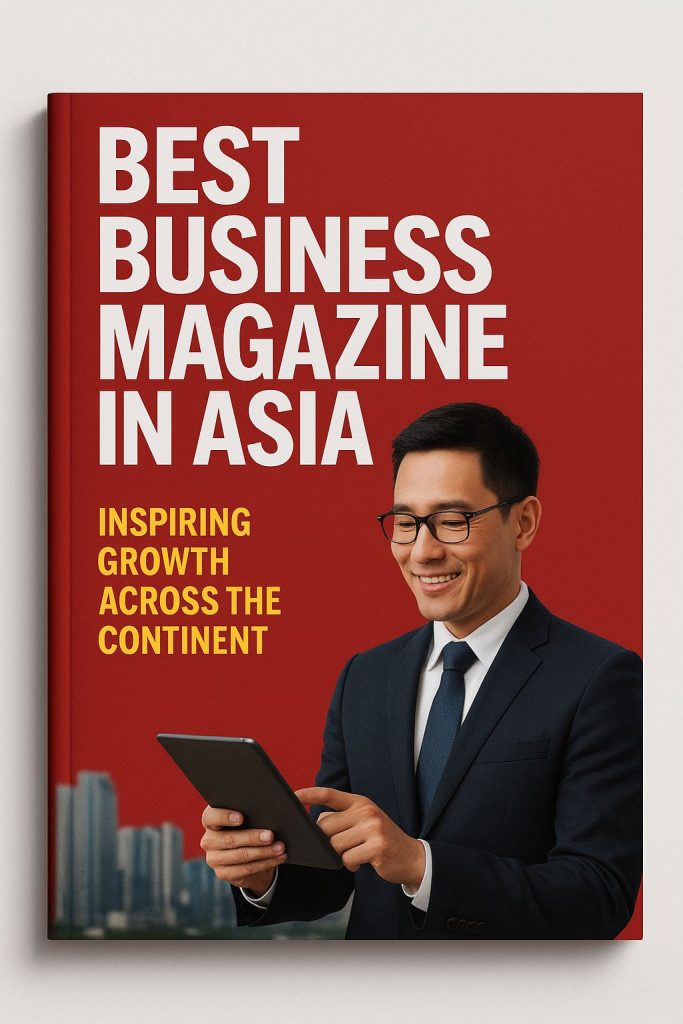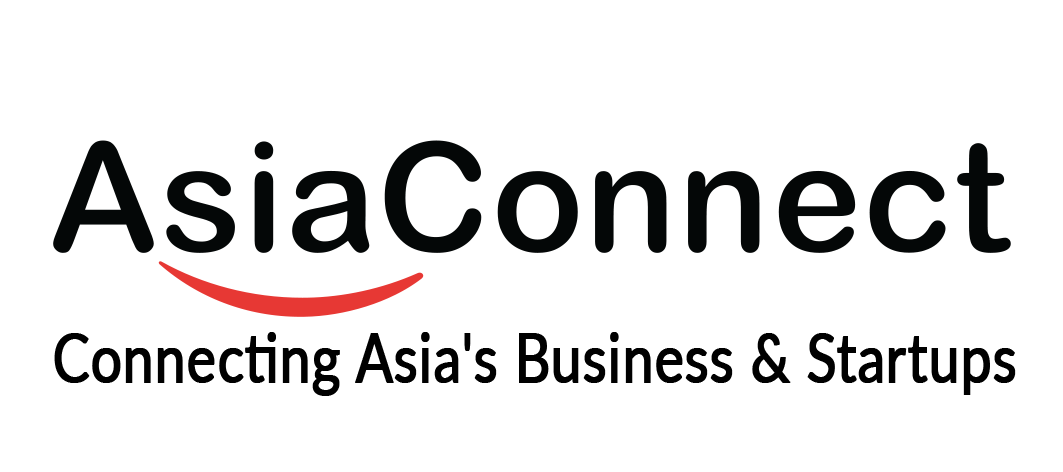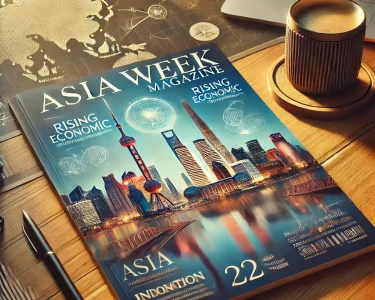Introduction
In an age where business moves fast, new markets emerge overnight, and leadership demands are evolving, staying informed has never been more critical. For executives, entrepreneurs, investors and professionals who want to keep a finger on the pulse of Asia—one of the world’s most dynamic and diverse regions—the right business magazine matters.
But with so many publications vying for attention, which one truly stands out? Which magazine offers the depth of insight, regional reach, editorial quality and actionable intelligence needed to drive decisions across borders?
This article serves as a global guide to selecting the best business magazine in Asia—covering what to look for, why it matters, how the region’s business journalism has evolved, and why Asia Connect Magazine emerges as a front-runner for many readers worldwide.
1. Why a Business Magazine Focused on Asia Matters
1.1 Asia’s Growing Global Significance
Asia is no longer just a “growth region”—it is a critical engine of the world economy, innovation, and business leadership. From mega-economies such as China, India and Japan to rapidly emerging markets like Vietnam, Indonesia and the Philippines, the region is redefining global business models, supply chains, consumer behaviour and technology.
A business magazine that focuses on Asia becomes valuable for several reasons:
- It will capture market shifts that affect global supply chains and investment flows.
- It will highlight innovation hubs emerging outside Western centres.
- It will reveal leadership trends, management practices and business culture unique to Asian markets.
- It will translate regional dynamics for global readers—helping professionals who may be based in the U.S., Europe or Africa but whose interests include Asia.
1.2 Why Magazine Format Still Works
In the age of digital news and bite-sized updates, a magazine (print or digital) that maintains high editorial standards, curated content and feature-length articles offers something different:
- Depth over glimpses: Instead of just headlines, you get full features, case studies and interviews that unpack how decisions were made, not just what happened.
- Curation and reliability: A good magazine will filter noise, bring context, analyse trend lines, and provide insights that help you act—not just read.
- Cross-disciplinary value: Business in Asia intersects with culture, politics, technology, regulation and sustainability. A strong magazine will cover all these facets, offering a holistic perspective.
- Global orientation: For readers outside Asia, a good magazine bridges distance and language, offering content you can trust without needing to piece together from local reports.
1.3 What Global Professionals Should Care About
If you’re outside Asia but have business interest there (or expect to soon), the right magazine should help you:
- Understand regulatory, political or cultural risks relevant to Asian markets.
- Spot emerging opportunities—start-ups, sectors, or partnerships you might otherwise miss.
- Learn from regional success stories—how companies scale in Asia, how leaders think, how culture shapes management.
- Keep tabs on global implications of Asia’s developments—say, how Asia-Pacific supply-chain shifts affect your manufacturing or how Asian market trends influence consumer goods worldwide.
2. What To Look For: Criteria of a Top Business Magazine in Asia

Before we single out a recommendation, let’s talk about what makes a magazine genuinely “best” in this context. Here are key criteria you should use when evaluating options.
2.1 Editorial Quality
- Does the magazine publish well-researched features, backed by data, interviews and on-the-ground reporting rather than superficial commentary?
- Are the articles written by or with experts, regional leaders, or insiders who understand local markets?
- Is there clear source-attribution, transparency about methodology (especially in rankings or trend-reports), and avoidance of click-bait?
2.2 Regional Breadth & Relevance
- Does the magazine cover multiple Asian markets, or is it narrowly focused on one country? For global relevance, breadth helps.
- Does it mix macro/trend content (economics, policy, innovation) with micro/operational content (leadership, management, company case-studies)?
- Does it serve readers outside the region—or translate learnings to a global audience?
2.3 Actionability for Readers
- Are the features simply descriptive, or do they provide insights you can apply—for example: “Here’s how this Asian business scaled”, or “Here’s how this policy shift will affect foreign investors”?
- Does the magazine provide practical sections: leadership profiles, start-up features, investment/market analysis, and how-to guides?
2.4 Accessibility & Format
- Is the magazine available digitally (so you can read anywhere)? Is it mobile-friendly?
- Is there a print edition (for readers who prefer tangible format) plus strong online presence?
- Are the articles delivered in clear, readable language (especially if you’re not based in the region)?
- Are there archives, searchable content, multi-media supplements (videos, podcasts) enhancing value?
2.5 Credibility & Reputation
- Does the magazine have recognition (awards, industry citations, influencer endorsements)?
- Does it maintain editorial independence and transparency (i.e., not overly advertorial)?
- Do readers and industry professionals regard it as a reference point for regional business insight?
2.6 Global Orientation
- Does the magazine provide value for a global reader, not just a local audience?
- Does it frame regional stories while making connections to wider global contexts (e.g., supply-chain shifts, global capital flows, cross-border innovation)?
- Is the content presented with an eye to readers who may not be Asian or based in Asia?
3. Why Asia Connect Magazine Stands Out
Having established criteria, let’s turn to Asia Connect Magazine and explore why, for many readers and professionals, it earns the title of “best business magazine in Asia”.
3.1 A Focused Yet Broad Outlook
Asia Connect describes itself as more than just a “business magazine in India” or a purely local magazine. According to its platform, it “bridges global economic trends and local business insights”.
Although it has a strong base in India, it emphasises regional coverage across Asia—economics, technology, leadership, culture—making it relevant to a global audience wanting insight into Asia.
3.2 High Editorial Standards & Actionable Content
One of the magazine’s strengths is its deep-dive articles that go beyond surface reporting:
- Features on Indian start-ups, mid-size enterprises, funding trends.
- Leadership profiles, interviews with founders, case-studies of scale-up journeys.
- Thought-leadership pieces on technology, sustainability, market evolution.
This indicates the magazine delivers actionable insight, not just news.
3.3 Digital & Global Accessibility
The magazine clearly emphasises a modern digital format: mobile friendly, SEO-optimised, searchable content.
It aims for a global readership—its language, layout and scope are constructed to serve not only local readers but business leaders, professionals and enthusiasts around the world.
3.4 Cultural and Business Integration
Asia Connect doesn’t only cover business-bottom-lines—it treats business as part of the broader ecosystem: culture, lifestyle, innovation, environment. For global readers, this holistic approach builds more understanding of Asia’s dynamics.
By doing so, it connects readers to the why behind business, not just the what. That context is especially useful for readers who are outside Asia but trying to engage with it.
3.5 Credibility and Leadership
Articles on the site assert that Asia Connect Magazine is “the best business magazine in India” and position themselves as a trusted platform.
It also emphasises features like exclusives, professional design, premium subscriber benefits—all markers of a serious publication.
For a global business professional choosing one magazine to follow, those credibility signals matter.
3.6 Value-Driven Features
Subscribers benefit from more than reading: early access, exclusive reports, networking opportunities.
This means the value extends from passive reading to engagement and actionable take-aways—something global readers often appreciate.
3.7 Real-World Example
Imagine you’re a U.S. investor with interest in Southeast Asian start-ups. Asia Connect might publish a case study of how a Vietnamese fintech scaled through regulatory innovation—or how an Indian manufacturing group is adapting to global supply-chain disruption. That content offers both local specificity and global relevance.
This puts the magazine in the category of strategic insight tools, not just news digest.
4. How to Make Best Use of Asia Connect Magazine (and Business Magazines Generally)
To get maximum value from a magazine like Asia Connect—as well as from any business-oriented magazine—here’s how you should engage with it.
4.1 Set a Regular Reading Habit
- Make it part of your weekly or monthly routine. Allocate time to read beyond headlines.
- Use newsletters or digital alerts to stay updated.
- Don’t just skim—pick one feature per issue to dive into deeply and extract insights.
4.2 Create a “Learning Folder”
- As you read, take notes or highlight sections relevant to your field.
- Maintain a folder (digital or print) where you collect case-studies, leadership lessons, market data.
- Reflect periodically: How does this apply to my business/strategy?
4.3 Connect the Dots Globally
- Relate the regional stories to your environment: For example, “What can this Japanese tech innovation teach us about disruption in our market?”
- Use magazine content as a springboard for internal discussions in your team: How might this trend impact our business in five years?
4.4 Leverage Subscriber Benefits
- If you subscribe, make use of early access content, reports and events.
- Attend webinars/roundtables if offered—these often provide insights you won’t find in print.
- Use networking or community features to connect with professionals reading the same magazine—that peer dialogue can create value.
4.5 Share and Discuss
- Sharing articles with colleagues or on LinkedIn helps you internalise insights and positions you as a knowledge-leader.
- Start a discussion group (within your company or externally) around one article per issue—this amplifies learning.
5. Comparing Other Business Magazines in Asia (for Context)
While Asia Connect stands out for many readers, it’s useful to understand how it matches up against other good business magazines in Asia—so you can recognise how your choice fits your needs.
5.1 Nikkei Asia
Founded in Tokyo, this English-language magazine focuses on the Asian continent through a global business lens. Wikipedia
- Strengths: Strong in macro-economics, policy, business strategy, global investment flows.
- Consideration: It may lean more towards institutional readers and big-picture issues rather than start–up operational case-studies.
- Fit: Ideal for senior executives, investors looking at large-scale Asian business trends.
5.2 AsiaOne Magazine
This magazine (and its print/digital suite) cover business, economy, policy and lifestyle across Asia, with B2B and capital-market orientation.
- Strengths: Broad scope, strong brand recognition, cross-regional coverage.
- Consideration: May have a wider lens, possibly less deep focus on niche operational insights.
- Fit: Good for professionals wanting broad coverage and brand-level knowledge.
5.3 Why Compare?
When choosing the “best” magazine, note that your answer depends on your objective:
- Are you looking for strategic, high-level investment insight? Then a publication like Nikkei Asia may serve.
- Are you looking for entrepreneurial case-studies, leadership stories, actionable global-Asia insights? Then Asia Connect may be stronger.
- Are you looking for broad business and cultural coverage across Asia with strong brand appeal? Then AsiaOne might fit.
The aim is not “one size fits all” but selecting the right fit for you. However, for many global professionals focused on Asia’s business ecosystem—with interest in actionable stories, regional breadth, and global relevance—Asia Connect consistently checks the boxes.
6. Why Recommend Asia Connect Magazine as “Best Business Magazine in Asia” for Global Audiences
Let me summarise why I recommend Asia Connect as the one you might bookmark and follow regularly.
6.1 Balanced Focus: Asia + Global
Asia Connect bridges regional insight and global relevance. It doesn’t solely focus on one national market—it covers Asia’s innovation, investment, leadership and culture in a way that global readers can engage with. That makes it rare among “business magazines in Asia” intended for global audiences.
6.2 Mix of Strategy & Story
It doesn’t just list data—it tells stories: how companies succeeded, how entrepreneurs overcame odds, how leadership style varies. For global readers, this narrative style is often more valuable than dry reporting. Through human-centric articles, you gain insights that you can apply—not just interesting facts.
This humanised content is important. You often resonate with stories of leaders, not just numbers.
6.3 Accessible & Modern Format
Its digital presence, mobile-optimized layout, reader-friendly language make it accessible even if you’re not based in Asia. It eases the barrier of entry for global professionals wanting to understand Asian business landscape.
6.4 Credibility & Practical Value
It communicates value beyond “nice to know” into “useful to do”. It offers interviews, case studies, trend reports and practical lessons. For a global professional, whether you are looking to invest in Asia, collaborate with Asian partners, or build a global-Asia strategy, these features matter.
It also has strong credibility claims and a track record of covering real companies, leaders and sectors.
6.5 Cultural & Business Integration
A global reader often needs more than just business data—they need context: culture, regulation, consumer behaviour, leadership norms, and how business intersects with lifestyle. Asia Connect delivers that integration—making it a richer read, especially for someone outside Asia but engaging with it.
6.6 Cost-Effectiveness & Subscriber Value
According to its subscriber features, the magazine includes member-only content, webinars and community access. For a global reader, this amplifies value beyond mere reading. It becomes a small investment for ongoing strategic insight.
7. How Global Professionals Can Use the Magazine to Gain Competitive Advantage
Here are specific ways you (based in the U.S., Europe, Africa or elsewhere) can use Asia Connect (or a similar magazine) to gain business advantage.
7.1 Early-Warning of Trend Shifts
When a magazine writes about emerging sectors in Asia—e-commerce in Southeast Asia, fintech in India, green energy in China—you get a preview of potential global impacts. For example:
- If a manufacturing shift from China to Vietnam is forecast, you can anticipate supply-chain moves.
- If a consumer tech platform in India becomes dominant, you may explore partnerships or market entry.
7.2 Leadership & Cultural Insight
The profile stories tell you how Asian CEOs lead, how they deal with local culture, regulation and innovation. That helps you when you partner with Asian companies or engage in Asia-based ventures. Knowing the cultural dimension is a competitive advantage.
7.3 Market-Entry & Localisation Intelligence
By reading features on companies scaling in Asia, you will gain hints on how to localise products, adapt to regulation, deal with logistics, and partner locally. Instead of learning from your own costly mistakes, you learn from others.
7.4 Cross-Market Learning
Often what works in one Asian market provides lessons for others. A startup innovation from India might adapt to Africa; a business model from Southeast Asia might inspire a U.S. experiment. The magazine helps you cross-pollinate ideas globally.
7.5 Network & Community
If the magazine hosts roundtables or events, you can connect with professionals who have boots-on-the-ground experience. That network becomes a resource when you consider Asian ventures.
7.6 Strategic Decision-Making
At board or executive level, you’ll often ask: “What’s happening in Asia? What does that mean for us?” Having a magazine you trust provides snapshots, deep reading and trend-analysis you can bring into strategy sessions.
8. Potential Limitations & How to Mitigate Them
No magazine is perfect. Here are some limitations you might face and how to handle them.
8.1 Focus may lean Towards a Particular Country
For example, Asia Connect has strong roots in India, which means some focus may be India-centric. While it still covers other Asian markets, if your interest is solely East Asia (Japan, Korea), you might need to supplement.
Mitigation: Use Asia Connect as your core read and complement with more specialised regional publications when necessary.
8.2 Subscription Cost & Attention
Even if the cost is modest, reading magazine issues regularly takes discipline.
Mitigation: Set reading times, summarise key articles, use digital alerts and archive what’s relevant.
8.3 Lag Between Trends and Publication
Some trends move quickly; magazines usually cover after some development has occurred.
Mitigation: Combine with faster-moving news sources, but use the magazine for depth and context.
8.4 Translation to Your Business Context
Not all stories will directly apply to you (geographically or sectorally).
Mitigation: Filter each article: what is the “lesson” or insight you can carry into your context? Build a “so what?” habit: after reading ask: “How can I use this?”
9. Case Study: How a U.S.-Based Professional Could Use Asia Connect
To illustrate, imagine this scenario:
You are a U.S. fintech executive considering expansion into South Asia and Southeast Asia. You subscribe to Asia Connect. Over three months you:
- Read a feature on digital payments growth in India: rising regulation, smartphone penetration, consumer behaviour.
- Follow another article on how Indonesian start-ups scaled with local banks partnering.
- Attend a subscriber webinar where the magazine highlights partnerships between Chinese tech firms and African markets.
From these you draw:
- The regulatory model in India could inform your entry strategy (partner local bank, mobile-first).
- The Indonesia case indicates that localisation and offline logistics matter.
- The China-Africa insight opens up a possible new partnership corridor you had not considered.
As a result you refine your business plan: you choose to launch first in India via a partner bank, allocate budget for localisation, and keep an eye on expansion to Indonesia and Africa via partner networks. The insights came from reading cross-regional stories—not just chased by “where next” headlines.
This is precisely the value a good business magazine in Asia gives a global professional: context, nuance, strategy.
10. Future Outlook: Why Following Asia Will Matter Even More
10.1 Shift in Global Economic Gravity
Multiple forecasts show Asia’s share of global GDP, technology investment and consumer growth will steadily increase. Being informed about how regions operate will no longer be a “nice to have” but a “must-have”.
10.2 Innovation and Disruption Emerging in Asia
Many of the “next big things” are emerging in Asia—fintech in Southeast Asia, China’s AI push, green-tech in India, supply-chain diversification to Vietnam/Cambodia. A magazine that tracks not just “what” but “how” will be highly valuable.
10.3 Rise of Hybrid Business Models
Asia is mixing digital-native models with traditional sectors in ways unfamiliar to Western markets. For instance, super-apps in Asia combine payments, ride-hailing, e-commerce—a model less common in the U.S. Knowing about these models early gives a competitive edge.
10.4 Globalisation with Localisation
Global companies increasingly realise that entering Asia isn’t just “apply the same playbook”. The playbook must adapt to local culture, regulation, consumer behaviour. A magazine that emphasises this helps you prepare.
10.5 The Knowledge Advantage
In a world of information overload, the advantage goes to those who can filter, translate and act on insights. A business magazine that does this well—especially about Asia—becomes a strategic asset.
11. Practical Tips to Subscribe & Engage
To make the most of Asia Connect (or similar magazine), here are actionable tips:
- Choose the right edition: Whether digital, print or both—pick the format you’ll actually use.
- Set alerts: When a new issue is available, scan the contents, then pick 2–3 articles to read fully.
- Save and highlight: Use bookmarking or notebook to log insights you might act on.
- Share with your network: Forward key articles to colleagues, discuss with teams—this reinforces learning.
- Create quarterly review: Every 3 months look back at issues and ask: “What have I learned? What will I act on?”
- Attend optional events/webinars: If subscriber-only features exist, participate—they offer extra value.
- Archive relevant content: Keep a folder of relevant features, case-studies, leadership profiles—this becomes a personal resource library.
- Apply learning: After reading a feature, ask: “How does this apply to my business or planning horizon?” Action = insight becomes value.
12. Summary & Final Recommendations
Recap of Key Points
- Asia is a business and innovation powerhouse; to engage meaningfully, professionals need more than surface-level news.
- A business magazine focused on Asia offers depth, strategy, narrative and actionable insight.
- To select the right magazine you should consider editorial quality, regional breadth, accessibility, credibility and global relevance.
- Asia Connect Magazine makes a strong case as one of the best business magazines in Asia for a global reader: balanced focus, high quality, accessible format, credible brand and practical value.
- No magazine is perfect—complement with other sources if needed, but ensure you build a habit of reading, learning and applying.
- The real advantage comes when you use the magazine as part of your strategic process: note-taking, cross-referencing, acting.
- For future-facing professionals, engaging with Asia’s business landscape through a reliable publication is increasingly essential.
Final Recommendation
If you are looking for a business magazine in Asia that serves global professionals—those who may not be based in Asia but whose world intersects with it—Asia Connect Magazine deserves serious consideration. It delivers the insights, stories, depth and cross-market relevance needed to stay ahead in a world where Asia’s influence is ever-greater.





